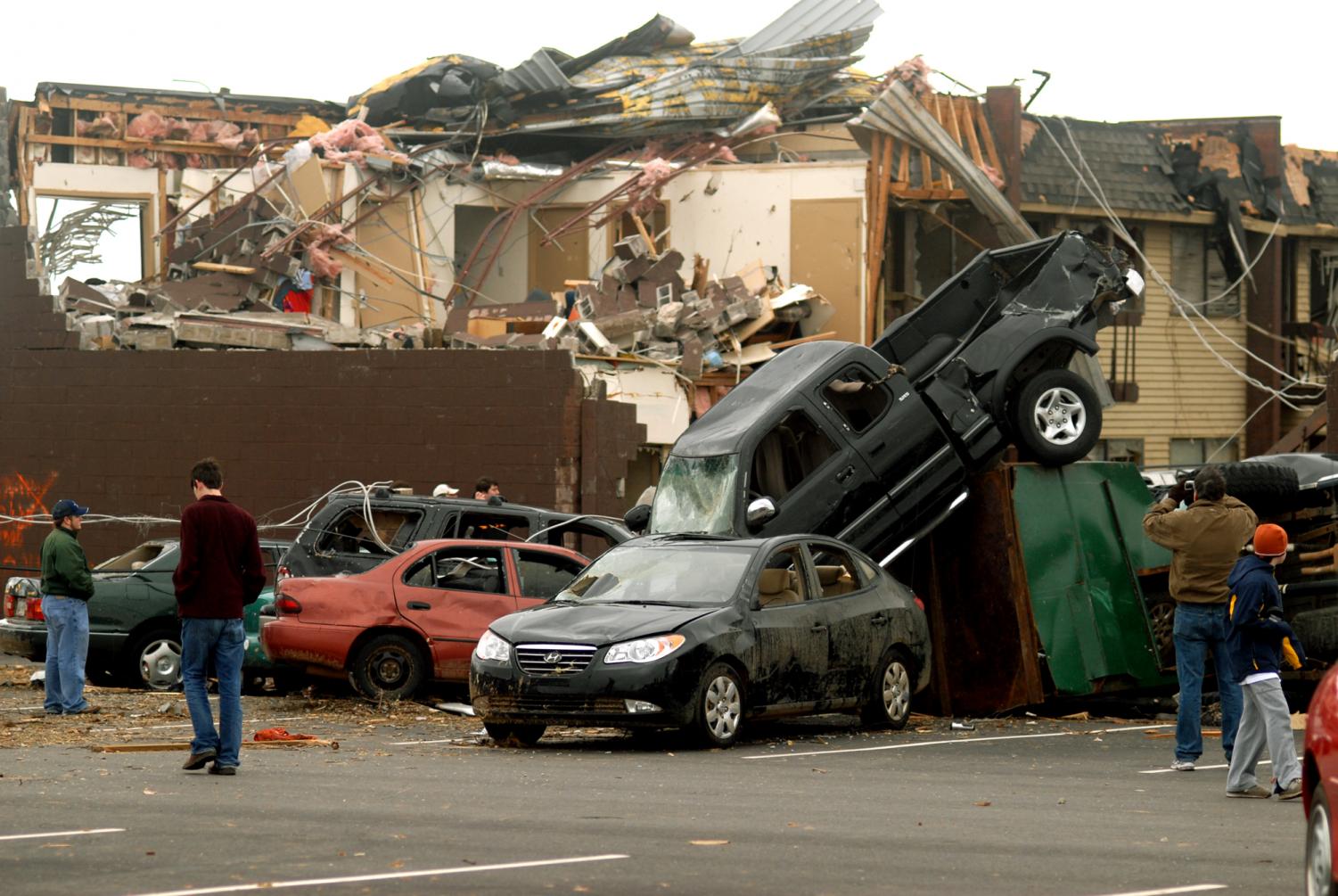Residents in five Southern states tried to salvage what they could from homes reduced to piles of debris on Wednesday, a day after the deadliest cluster of tornadoes in more than two decades tore through the region, snapping trees and crumpling homes. At least 59 people were killed.
Rescue crews, some with the help of the National Guard, went door-to-door looking for more victims. Dozens of twisters were reported as the storms swept through Kentucky, Tennessee, Mississippi, Arkansas and Alabama.
Thirty people were killed in Tennessee, 13 killed in Arkansas, seven killed in Kentucky and four killed in Alabama, emergency officials said. Among the victims were parents who died with their 11-year-old daughter in Atkins, Ark., when they stayed behind to calm their horses. The community, one of the hardest hit, is a town of about 3,000 approximately 60 miles northwest of Little Rock.
Biola University supported one of its fellow Christian universities on the Council for Christian Colleges and Universities that was hit by the tornadoes. President Barry Corey sent an e-mail to Biola faculty Wednesday morning asking everyone to keep the students and staff of Union University in their prayers.
“Biola joins many around the nation today in standing with our sister school in prayer for the faculty, staff, students and neighbors of Union University affected by the devastation,” Corey said in the e-mail.
In Wednesday morning’s chapel, Professor Noreen Muehlhoff informed students of what had taken place at Union University and throughout the southern states and asked students to pray for the people who were dealing with the damage.
More than 20 students were stuck behind wreckage and jammed doors, mostly for short periods, in battered dormitories at Union University in Jackson, Tenn. Tornadoes have hit the campus in the past, and students knew the drill when they heard sirens, said Union University President David S. Dockery.
“When the sirens went off the entire process went into place quickly,” Dockery said. ” [Students] were ushered into rooms, into the bathrooms, interior spaces.”
He said about 50 students were taken to a hospital and nine stayed through the night. But all would be fine, he said. According to Dockery, he was proud of the students because they “demonstrated who they are.”
Sarah McBroom, a junior at Union University, was one of the students on campus when the tornado hit.
“It was pretty crazy,” said McBroom. “I was actually really lucky because my dorm was at the opposite end of campus, and it wasn’t hurt at all.”
McBroom and her dormmates went into the bathroom on the lowest floor like they would in a regular tornado situation, but quickly realized that this was no ordinary tornado when someone knocked on the bathroom door and told all of the students they needed to move to an academic building on campus. When they walked outside, they were shocked.
“We had no idea the amount of damage that was done to the rest of the campus,” said McBroom. “Buildings had roofs and sidings pulled off … and cars were blown on top of each other.”
After changing location several times, the students were finally able to get off campus. Professors and local churches came to the university and took students to their homes so they could have a place to stay for the night, said McBroom.
McBroom’s parents came and picked her up from the university on Wednesday, but she is unsure of when she will be able to return to school. The original date that was given was Feb. 13, but it is now tentatively set for Feb. 18.
“[The time of return] depends on the amount of damage,” said McBroom. “There are some people who have lost everything they had at school.”
Union University created a blog specifically for updating parents and outsiders of what was happening on campus. It was periodically updated on Wednesday.
Seavia Dixon, whose Atkins, Ark., home was shattered, stood Wednesday morning in her yard, holding muddy baby pictures of her son, who is now a 20-year-old soldier in Iraq. Only a concrete slab was left from the home. The family’s brand new white pickup truck was upside-down, about 150 yards from where it was parked before the storm. Another pickup truck the family owned sat crumpled about 50 feet from the slab.
“You know, it’s just material things,” Dixon said, her voice breaking. “We can replace them. We were just lucky to survive.”
Ray Story tried to get his 70-year-old brother, Bill Clark, to a hospital after the storms leveled his mobile home in Macon County, about 60 miles northeast of Nashville. Clark died as Story and his wife tried to navigate debris-strewn roads in their pickup truck, they said.
“He never had a chance,” Story’s wife, Nova, said. “I looked him right in the eye, and he died right there in front of me.”
President Bush called the governors of Alabama, Arkansas, Kentucky, Mississippi and Tennessee to assure them the administration was ready to help and to deal with any emergency requests.
“Loss of life, loss of property — prayers can help and so can the government,” Bush said. “I do want the people in those states to know the American people are standing with them.”
The system moved eastward to Alabama on Wednesday, bringing heavy rain and gusty wind, causing several injuries in counties northwest of Birmingham. The National Weather Service posted tornado watches for parts of southern Alabama, the Florida Panhandle and western Georgia, but the storms appeared to weaken as they approached the coast. Weather service experts also investigated damage in Indiana to see if it was caused by tornadoes.
An apparent tornado damaged eight homes in Walker County, Ala., and a pregnant woman suffered a broken arm when a trailer home was tossed by the wind, said county emergency management director Johnny Burnette.
“I was there before daylight, and it looked like a war zone,” he said.
Northeast of Nashville, a spectacular fire erupted at a natural gas pumping station. The station took a direct hit from the storm, but no deaths connected to the fire were reported.
About 200 yards from the edge of the plant, Bonnie and Frank Brawner picked through the rubble of their home for photographs and other personal items. The storm sheared off the second story of the home.
“We had a beautiful neighborhood, now it’s hell,” said Bonnie Brawner, 80.
In Memphis, high wind collapsed the roof of a Sears store at a mall. Debris that included bricks and air conditioning units was scattered on the parking lot, where about two dozen vehicles were damaged.
A few people north of the mall took shelter under a bridge and were washed away in the Wolf River, but they were pulled out with only scrapes, said Steve Cole of the Memphis Police Department.
This batch of tornadoes was the nation’s worst in a 24-hour period since May 3, 1999, when some 59 people died in Oklahoma and Kansas. The death toll ranks among the top 15 from tornado outbreaks since 1950, said Greg Carbin, the warning coordination meteorologist at the center in Norman, Okla., just south of Oklahoma City.
The tornadoes could be due to La Nina, the cooling of the tropical Pacific Ocean that can cause changes in weather patterns around the world. It is the opposite of the better-known El Nino, a periodic warming of the same region.
In this round of storms, there were 67 eyewitness accounts of tornadoes but the number of twisters likely won’t be that high because some probably saw the same funnel cloud, said Carbin. He said a reasonable guess is that 30 to 40 tornadoes touched down.
Most communities had ample warning that the storms were coming — forecasts had warned for days that severe weather was possible. But in at least one rural community, there was no siren to alert residents the severe weather had arrived.
In Kentucky’s Allen County, officials have requested funding for a siren at the fire station, but don’t have one yet. Even if they did, officials wondered if it would have helped.
“It came in quick,” Judge-Executive Bobby Young said. “Probably, warning devices wouldn’t have helped any.” Contributing to this report were Associated Press writers Ryan Lenz in Greenville, Ky., Jon Gambrell in Atkins, Ark., Holbrook Mohr in Jackson, Miss., Seth Borenstein in Washington, Murray Evans in Oklahoma City and Woody Baird in Memphis, Tenn.







